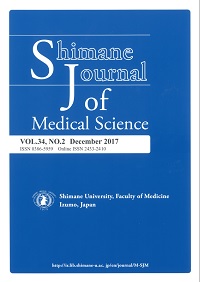Shimane University Faculty of Medicine
ISSN :0386-5959(in print)
ISSN :2433-2410(online)


These article are licensed under a Creative Commons Attribution-NonCommercial-NoDerivatives 4.0 International License.
number of downloads : ?
Use this link to cite this item : https://ir.lib.shimane-u.ac.jp/40710
Shimane Journal of Medical Science 34 2
2017-12-31 発行
Two Fatal Cases of Caffeine Poisoning and a Review of the Literatur
Fujihara, Junko
Department of Legal Medicine
Yasuda, Toshihiro
University of Fukui
Kimura-Kataoka, Kaori
Department of Legal Medicine
Hasegawa, Masanori
Shimane Prefectural Police
Kurata, Satsuki
Kurata Clinic
Takeshita, Haruo
Department of Legal Medicine
Description
Caffeine is commonly used as a stimulant, and fatal
caffeine overdoses are increasing. In the present
study, two case reports showing a fatal blood concentration
of caffeine were reported and compared
to previously published case reports.
Case 1: A 19-year-old female was found dead in
her room. It was speculated that she ingested 84
tablets (100 mg) of a sleep-inhibitor product. The
caffeine levels in her cardiac blood and stomach
were 116 μg/ml and 619 μg/ml, respectively. There
was no macroscopic indication of any natural or unnatural
cause of death.
Case 2: The condition of a 47-year-old male deteriorated
suddenly. Hypothermia and excess sweating
were observed. After vomiting several times, he lost
consciousness. At autopsy, severe pulmonary edema
was observed. His cardiac blood caffeine level was
determined to be 171 μg/ml, which exceeds fatal
blood caffeine levels. However, there is no evidence
of his ingesting massive amounts of caffeine.
The blood caffeine concentration in previously
reported fatal caffeine ingestions ranged from 33 to
350 μg/ml. The two present cases are within this
range. The accumulation of data on blood caffeine
concentrations and ingestion amounts is helpful to
predict the intake amount of caffeine.
caffeine overdoses are increasing. In the present
study, two case reports showing a fatal blood concentration
of caffeine were reported and compared
to previously published case reports.
Case 1: A 19-year-old female was found dead in
her room. It was speculated that she ingested 84
tablets (100 mg) of a sleep-inhibitor product. The
caffeine levels in her cardiac blood and stomach
were 116 μg/ml and 619 μg/ml, respectively. There
was no macroscopic indication of any natural or unnatural
cause of death.
Case 2: The condition of a 47-year-old male deteriorated
suddenly. Hypothermia and excess sweating
were observed. After vomiting several times, he lost
consciousness. At autopsy, severe pulmonary edema
was observed. His cardiac blood caffeine level was
determined to be 171 μg/ml, which exceeds fatal
blood caffeine levels. However, there is no evidence
of his ingesting massive amounts of caffeine.
The blood caffeine concentration in previously
reported fatal caffeine ingestions ranged from 33 to
350 μg/ml. The two present cases are within this
range. The accumulation of data on blood caffeine
concentrations and ingestion amounts is helpful to
predict the intake amount of caffeine.
About This Article
Rights
Faculty of Medicine, Shimane University
Other Article
PP. 73 - 80
PP. 81 - 84
